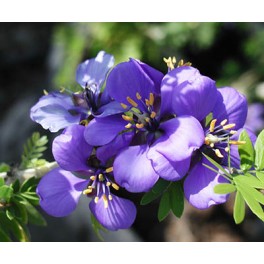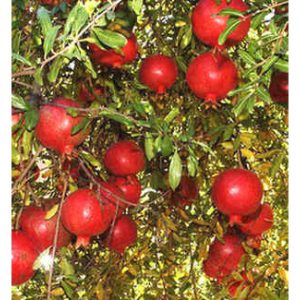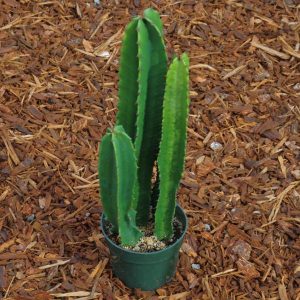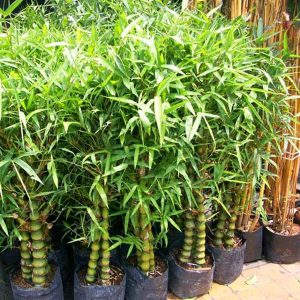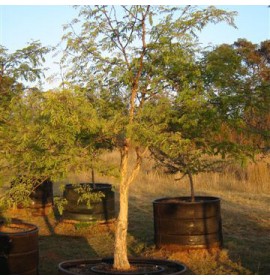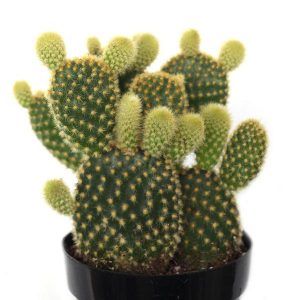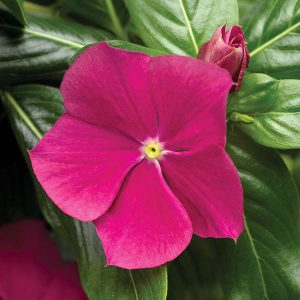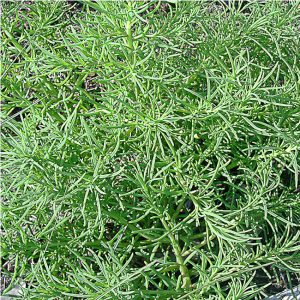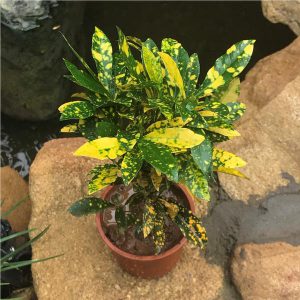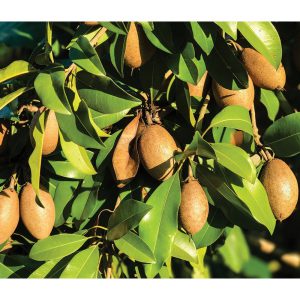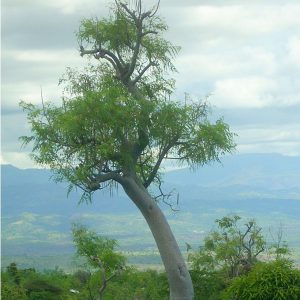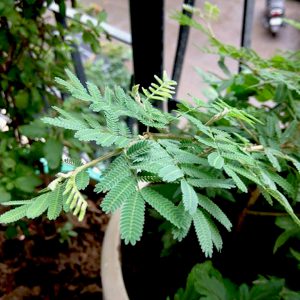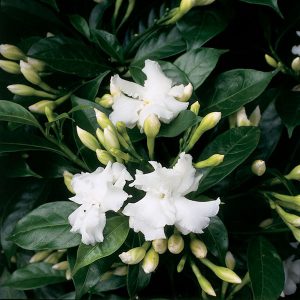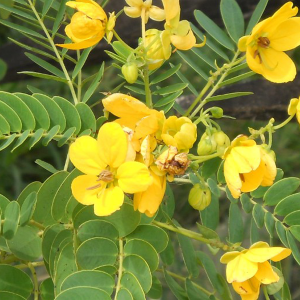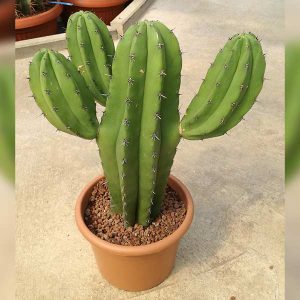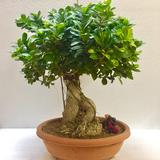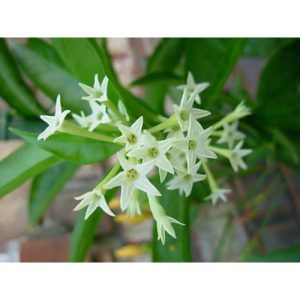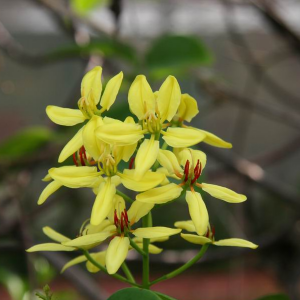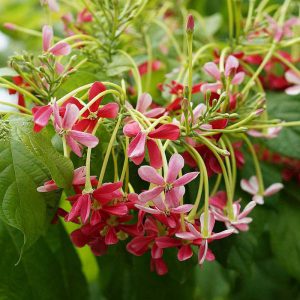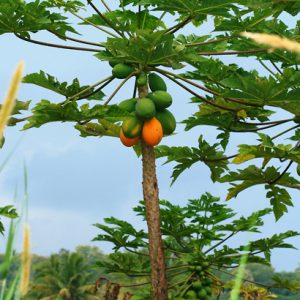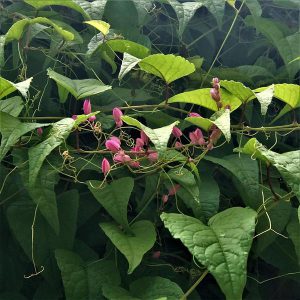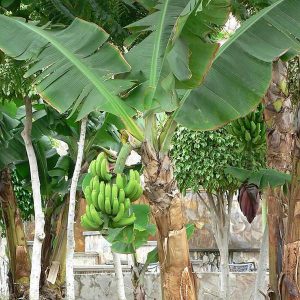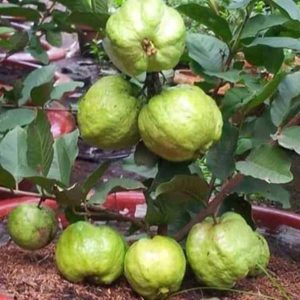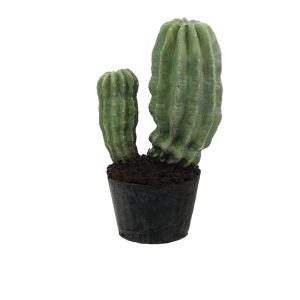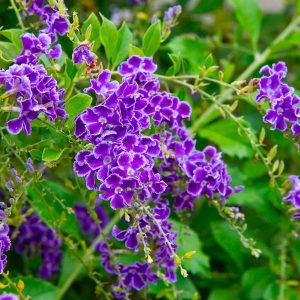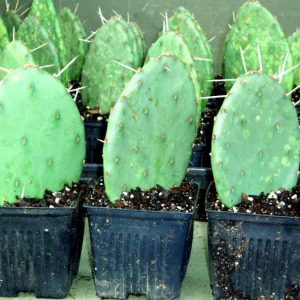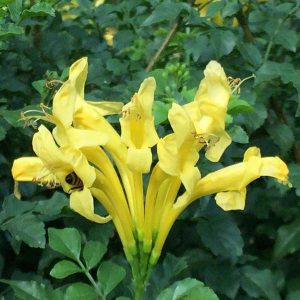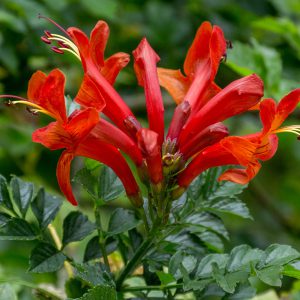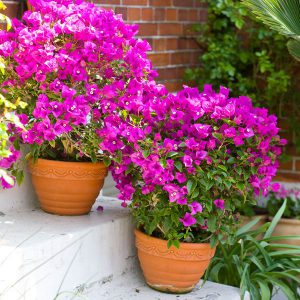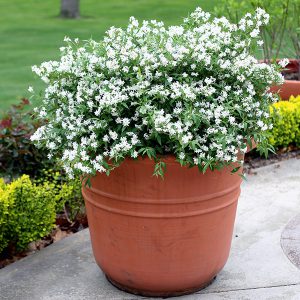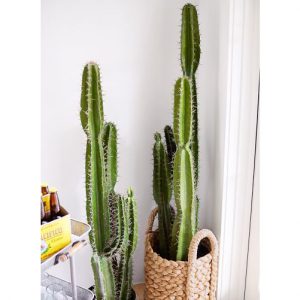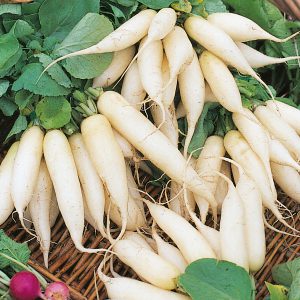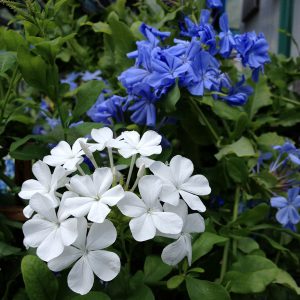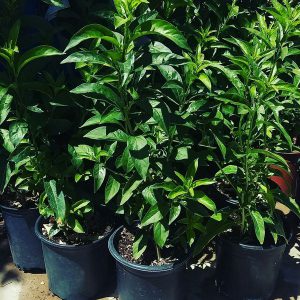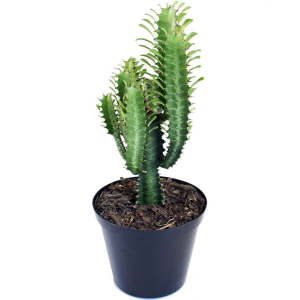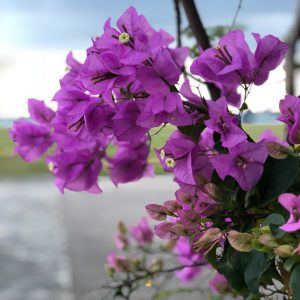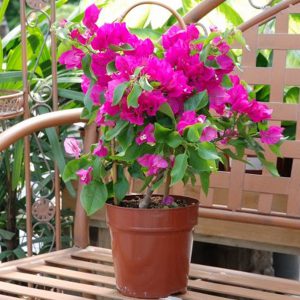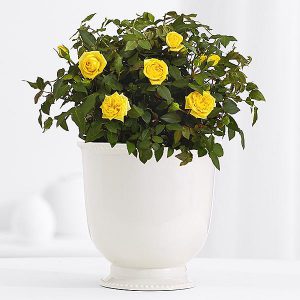Outdoor Plants
lignum (guaiacum officinale)
Loved for its purple to blue-violet flowers that yield bright red fruits, lignum vitae is heat, drought and salt tolerant, making it stupendous as a specimen in the coastal tropics. A rounded evergreen tree from the northern coastline of South America and the Caribbean islands, it is extremely slow growing and has a crooked, knotty form that adds to its beauty. The wood is very dense and does not float.
AED 110.00Add to cart
Punica granatum (pomegranate)
Pomegranate is a berry, with fruits being 5–15 cm (2-6 inches) in diameter, rounded in shape, with thick, red-brownish skin. The number of seeds can vary from 200 to about 1400 seeds. It is native to southeastern Europe and Asia and has been cultivated in ancient Egypt, Persia, India, Babylonia, Iran etc.
Plant is very ornamental, especially when flowering and some people grow them for their flowers and fruits are just a ‘byproduct’, loaded with vitamin C and other vitamins, minerals and antioxidants. Also, some varieties are grown only for their flowers.
AED 105.00Add to cart
Cactus Ingens
A potted cactus will live and flower in the house if given enough light, place the plant near a bright lighted window, where it will receive light most of the day. On the patio is different place the cactus in a partly shaded area until it become accustom to the sun. Never bring the cactus home and place it in the bright sun, cactus sun burn just like people
AED 105.00Read more
Buddha bamboo (chines Bamboo)
Buddha’s Belly Bamboo likes sunlight. Full sunlight helps the plant grow faster.
Part shading is essential for maintaining proper health of the plant.
The Buddha’s Belly plant is not very fond of water. It never needs much water to thrive and grow.
Watering the plant once a week can be enough when growing indoors.
It is essential to let the soil get completely dry after one watering session, before watering the plant the next time.
The plant should never be allowed to sit in water. That can cause the untimely death of the plant.
AED 105.00Add to cart
Acacia arabica
Acacia arabica Acacia arabica is a slow growing, long lived tree usually growing 2.5-7 m tall, but occasionally reaching up to 20
AED 100.00Add to cart
Bunny ear cactus collection
Cacti are the perfect plant for the novice gardener. They are also the perfect specimen for a neglectful gardener. Bunny ears cactus plant, also called angel’s wings, has ease of care combined with an original appearance.
AED 100.00Add to cart
Vinca Plant
Vinca is also popularly known as Madagascar periwinkle or myrtle. These flowering plants look beautiful and have attractive shiny and green foliage and delicate-looking flowers. Vinca flowers bloom during the entire summer and till the frost. They are also easy to grow and care for flowers.
There are around 12 flower types of vinca from which you can choose. There are some white-colored vinca which have different colors at the center like pink or dark red. Other varieties of vinca come in maroon, red, pink, and blue colors.
AED 96.00Add to cart
Sesuvium
No beating around the bush — this is one salty succulent. Eaten raw, the leaves proffer a salty and slightly bitter or acidic flavour with a crunchy succulent texture — great for pickling! When cooked, the flavours and textures soften suitably for a variety of savoury dishes and garnishes. Sea Purslane leaves are a good source of vitamin C and rich in the naturally occurring steroid, ecdysterone. This plant is also known for its haemostatic and anti-venom properties.
AED 96.00Add to cart
Codiaeum Variegated Gold dust
Like most houseplants, they also appreciate abundant humidity. You can boost humidity for your croton by growing it in a well-lit kitchen or bathroom, placing a small humidifier nearby, or grouping it nearby other houseplants.
Fertilize croton in spring and summer to keep it healthy and growing. Crotons only need fertilizer once or twice during the season, but you can get them to grow faster by fertilizing more frequently. Follow the directions on the fertilizer package whenever feeding your plants.
AED 95.00Add to cart
Chickoo plant in pot
Chickoo has brown fuzzy skin and is more oval-shaped than its Central American cousins, though some develop pointed ends. The skin is inedible, but serves a purpose as a kind of bowl for the sweet flesh. The flesh is off-white to a yellowish brown color and has a soft and juicy texture. The sweet flavor of the Chikoo flesh is due to the presence of high levels of fructose and sucrose. Its texture and flavor has been compared to that of pear. Within the flesh of the Chickoo is a cavity with two to three large black seeds. The seeds are inedible and should be discarded.
AED 95.00Add to cart
Morning oloifera (moringa)
What could be easier than walking into your yard, and gathering healthy leaves from your own grown Moringa plants to put on the table. The Moringa plant is a fast-growing, drought resistant tree that can reach up to 3 meters in its first year.
The Moringa tree is very easy to grow. Simply plant seeds or cuttings in a sunny spot. The moringa tree is a plant that grows mainly in semiarid, subtropical areas.
AED 90.00Add to cart
Ghaf national tree of uae (prosopis cineraria)
Ghaf trees (Prosopis cineraria) of UAE are considered as the National tree of UAE. In Abu Dhabi they are seen in the north eastern part of the Emirate. They are the largest trees in the sand sheets and dunes which depend on ground water for its survival. They have striated trunk, bipinnate leaves and have small thorns at the younger stage. The flowers are yellow and fruit is a pod which encloses several seeds.
The ghaf trees are a part of tradition and culture of UAE. The leaves are used as fodder, and also used as salad as they are rich source of protein; the honey from the flowers is of high quality. They have been used traditionally for medicinal purposes as well. They provide shade and shelter for humans and animals. They provide microhabitat for plants, birds and insects. Birds such as eagle owl and ravens built their nest on the tree
AED 90.00Add to cart
crepe jasmine TABERNAEMONTANA CORONARIA
Although the shrubs look elegant and refined, they are not at all picky about soil as long as it is well drained.
If you are growing crepe jasmine, you can plant the shrubs in full sun or partial shade. They require regular irrigation to keep the soil moist. Once the root systems are established, they require less water.
Crepe jasmine care is reduced if you are growing the plant in acidic soil. With slightly alkaline soil, you’ll need to apply fertilizer regularly to prevent the shrub from getting chlorosis. If the soil is very alkaline, crepe jasmine care will include more frequent applications of fertilizer.
AED 90.00Add to cart
Cassia surattensis
| Plant Morphology : Growth Form: Large-sized shrub or small tree, able to grow up to 7 m tall. Foliage: Even-pinnate green leaves with 6 – 9 pairs of leaflets, alternate, petioles measuring about 1.5 – 3 cm long, leaf measuring about 18 cm long, leaflets in pairs and usually obovate to oblong, measuring about 2.5 – 4 cm long and 1 – 1.7 cm wide, upper surface glabrous and lower surface slightly pubescent. Flowers: 10 to 15 yellow flowers in a raceme from the upper leaf axils, measuring about 3 – 6 cm long, peduncle measuring about 2.5 – 5 cm long. Fruits: Fruit is a flat pod, glabrous with papery valves, measuring about 7 – 10 cm long and 1 – 1.5 cm wide, contains about 15 – 25 seeds, glossy flattened and each seed measuring about 8 mm long and 4 mm wide. |
| Etymology : Genus Senna is derived from the Arabic name “sana”, which refers to the laxative leaves and pods. Species surattensis means from Surat, Southeast Gujarat state, India. |
| Ethnobotanical Uses : Food (Herb & Spice) Medicinal (Leaves used as laxative to treat constipation.) |
| casuarina sumatrana (rhu bukit) |
AED 90.00Add to cart
Polaskia Chichipe Cactus
This is a cactus which came with me from London to Spain and it flourished! In the photo taken in 2009 the difference between the old and the new self is very visible. The colour changed and also the width increased.
With less than ideal conditions from 2011 (moved from Spain to Northen Italy) the tip became thinner.
AED 90.00Read more
Ficus bonsai Ginseng
Ginseng Ficus is a low-maintenance bonsai that can be grown indoors or outdoors. Of course if you live in an area where temperatures drop below 68 degrees, your little tree should be grown indoors. This type of bonsai can survive without direct sunlight, but you will have a much happier and healthier tree if you place it near a window or an area that receives a lot of sunlight.
AED 85.00Add to cart
cestrum nocturnum (night blooming jasmine)
- Water your plants freely during spring and summer, reducing the volume of water required in winter. Plants that are placed in containers require a monthly high potassium feed (such as a tomato fertiliser) as this will provide additional nutritional value. Summer jasmine are best pruned after they flower during late summer or early autumn. Hardy perennial.
AED 75.00Add to cart
Tristellateia australasiae
An attractive ornamental liana that is widely grown for its beautiful and showy trusses of bright yellow flowers.
Mostly cultivated in the tropics or sub-tropics to lend beauty to the landscape. Its rampant and vigorous growth make it ideal for trellises, arches and pillars at porches, or as a hedge on fences, and even espaliered on walls.
AED 70.00Add to cart
Rangoon creeper (quisqaalis indica)
Amongst the lush foliage of the world’s tropical forests one will find a predominance of lianas or vine species. One of these creepers is the Quisqualis rangoon creeper plant. Also known as Akar Dani, Drunken Sailor, Irangan Malli, and Udani, this 12-foot long vine is an aggressively fast grower which spreads rapidly with its root suckers.
The Latin name for rangoon creeper plant is Quisqualis indica. The genus name ‘Quisqualis’ means “what is this” and for good reason. Rangoon creeper plant has a form more closely resembling that of a shrub as a young plant, which gradually matures into a vine. This dichotomy flummoxed early taxonomists who eventually gave it this questionable nomenclature.
AED 70.00Add to cart
Papya mam (carica papaya)
- Try your hand at papaya growing with this lovely looking, palm like sub tropical plant..
- Whilst not hardy outside the papaya (Carica papaya) makes a superb sunny conservatory specimen.
- The deeply lobed glossy green leaves alond stand comparison with even the best indoor plants.
- As the plant matures it bears lovely white blossom followed by the familiar elogated fleshy fruits
- Supplied as an established plant 70-80cm tall in 5L pot. For best results keep moist always and feed reularly.
AED 70.00Add to cart
Mexican creeper (antigonon leptopus)
A. leptopus is native to Mexico. Outside its native range, this species is widely naturalized and cultivated as an ornamental in warm, tropical climates around the world, including Africa, India, Australia, North, Central and South America, West Indies, and numerous islands in the Pacific Ocean.
AED 70.00Add to cart
Banana
As mentioned, banana plants grow from a corm or rhizome and produce a pseudostem made up of furled leaves and the start of the banana flower.
As the plant grows and matures, the leaves emerge and the flower blossoms transform into a berry like fruit that start out curling up toward light.
Collectively, all the fruit is called a “bunch”. As the bananas mature they begin growing downward separating into smaller groups called “hands”. Each individual banana within the hand is referred to as a “finger”.
It takes approximately nine months for banana plants to mature, grow leaves, flower and produce fruit. Once completed the parent plant dies back and baby plants (a.k.a. suckers or pups) take its place.
AED 65.00Add to cart
Psidium guajava (guava tropial)
The common guava is easy to grow and tolerates adverse conditions. The tree is attractive and the patchy bark lends visual interest. It bears prolific quantities of fruit. The aromatic fruit is well regarded thhroughout the American tropics and beyond. Unfortunately, the guava is a primary host of the Caribbean fruit fly. In addition, it is classified as an invasive exotic. When making planting decisions, the gardener should weigh these two drawbacks against the guava’s many attibutes.
AED 60.00Add to cart
Soguaro Cactus
A saguaro cactus (Carnegiea gigantean) is a columnar cactus that is native to the Sonoran desert in Arizona, California and Mexico. It provides cavity nesting for a variety of birds, and can be used as a food source for humans and wild animals. Because sustained freezing temperatures will quickly kill a saguaro, some gardeners must bring their cacti indoors for the winter. Whether you are growing a saguaro for permanent indoor occupation, or simply saving the cactus from freezing temperatures, the proper care of the cactus is required to help it stay healthy and thriving.
AED 60.00Read more
durant erecta (sapphire shower)
The “Sapphire Showers” golden dewdrop (Duranta erecta “Sapphire Showers”) adds interest to the landscape with its clusters of bluish-purple, trumpet-shaped flowers. Flowers appear in summer and attract butterflies. Also known as Picotee sky flower or pigeonberry, this fast-growing specimen prefers full sunlight and well-draining, slightly acidic soils.
AED 60.00Add to cart
cactus ears
This classic cactus has large, flat, dusty green paddles with lots of sharp thorns. The thorns are evenly distributed across the pads and also form an areola at the tip of each pad.
In addition to stationary thorns, the prickly pear also produces loose thorns called “glochids”. These thorns are barbed and can fasten onto skin and clothing.
With all of these thorns, it’s a bit hard to understand why the Opuntia is such a popular ornamental cactus until you see the blossoms, which grow from the areola of thorns.
AED 60.00Add to cart
Tecomaria Capensis Yellow
Train a climbing vine cape honeysuckle plant on a trellis or other supporting object using plant ties to support the vines. To maintain the shape of shrubs, prune long or unruly branches back to a side branch or bud with sharp pruning shears. Cut off old, damaged or dead branches at their base and remove them. Do this in the springtime before new growth begins.
AED 55.00Add to cart
Tecomaria capensis – cape honeysuckle
Sometimes I think I must have been part hummingbird growing up. Like those tiny birds, I loved to sip the nectar from the cape honeysuckle plants that I came across in Southern California. I didn’t have their long tongues, though, and I plucked many a flower from the poor shrubs. The blossoms are abundant, though, so my destructive habit didn’t compromise their beauty too much.
AED 55.00Add to cart
Bougain villea pink pixie
When it comes to watering, Bougainvillea is pretty drought tolerant once established. It prefers a good, deep watering every 3-4 weeks rather than frequent shallow waterings. When establishing, be sure to give yours regular water. It’s subject to a few types of root rots so don’t over water. The soil should be well drained which will help prevent rot.
AED 55.00Add to cart
Wrighta antidysentrica milky way – snawflake
The leaves are used in treating several skin disorders, psoriasis, nonspecific dermatitis etc. The bark is used as an adulterant for the well known drug, Holarrhena antidysenterica.
AED 50.00Add to cart
Saguaro cactus
Water the saguaro every 10 to 14 days. The soil should dry out completely before you need to water again. Check the soil to 4 inches deep with your fingers. If you feel even a slight bit of moisture, wait a few days to water. Even though the Saguaro is indoors, you should still follow a seasonal watering schedule. When the nighttime temperatures dip below 60 degrees F, discontinue watering altogether until the nighttime temperatures stay above 60 degrees F.
AED 50.00Read more
Radish white
Chinese white radish is a cruciferous vegetable that does well in conjunction with carrots, parsley or parsnips. The radish seeds are sown directly into the ground. Plant seeds 1/2 inch deep, one inch apart in rows spaced 12 inches apart. After sprouting, thin shoots to two inches apart. Watering frequently is imperative to maintain moist soil. Add nitrogen-rich fertilizer or manure to the soil to improve the root growth and leaf structure.
AED 50.00Read more
Plumbago (plumbago auirculata)
The plumbago plant (Plumbago auriculata), also known as the Cape plumbago or sky flower, is actually a shrub and in its natural surroundings can grow 6 to 10 feet tall with a spread of 8 to 10 feet. It is native to South Africa, and knowing this provides the first clue to how to grow a plumbago, along with where to grow one. Plumbago thrives in the South African heat and in the United States it is found growing year-round in the southernmost parts of Texas and Florida.
AED 50.00Add to cart
lawsonia inermis (henna tree)
Even though you may grow henna plant indoors with the assurance of direct sunlight, it is always preferred to grow it outdoors. This is because henna plants grow better in hot climates. The minimum temperature needed for a henna plant to grow and nourish well is 22ºC.
AED 50.00Add to cart
African milk tree cactus
african milk tree cactus African Milk Tree (Euphorbia trigona) is a tall, rugged, easy-care plant with thorns. It should come as no
AED 50.00Read more
Bougain villiea spectabilis soft pink
- Good for making bonsai
- Good for Topiary
- Good for screening
- Good for Hedges and Borders
- Can grow on trellis or chain link fencing
- Attracts butterflies
- Animals will not eat
- Thorny or Spiny
- Suitable for road median planting
- Hanging or weeping growth habit
- Salt or salinity tolerant
- Good on seaside
AED 48.00Add to cart
Bougain villea
Water a newly planted bougainvillea frequently to keep the soil moist. Once the plant is established, it blooms best if the soil is a little on the dry side. Water the plant until liquid drips through the drainage hole, then don’t water again until the potting mixture feels slightly dry. However, don’t allow the soil to become completely dry because a water-stressed plant won’t bloom. Water the plant immediately if it looks wilted.
AED 48.00Add to cart
Pennisetium
Pennisetum alopecuroides is a highly decorative ornamental grass, also known as Fountain Grass, and is a plant which gives almost all year round interest in the garden. It is a low-maintenance plant, which quickly forms a clump, so is ideal for filling gaps in perennial and shrub borders. The grassy foliage is neat, but stays quite inconspicuous until the flower heads appear during late summer. But, once they appear, they really dazzle, with spikelet’s looking much like a squirrel’s tail! Leave the decorative seedheads on your Fountain Grass plants into the autumn. Height: 150cm (59″). Spread: 120cm (47″).
AED 45.00Add to cart
Rosa plant
Caring for rose bushes is important to their overall health and vigor, especially when it comes to watering. Roses require at least an inch of water weekly throughout their growing season, beginning in spring or following spring planting. While overhead watering is suitable before the onset of new growth, it is often better to water these plants at the soil line using soaker hoses or similar means. Rose bushes are very susceptible to fungal diseases, such as black spot and powdery mildew, especially when their foliage is kept too wet.
AED 45.00Add to cart

